Business Law Report
VerifiedAdded on 2020/12/10
|10
|3416
|332
Report
AI Summary
This report examines the English legal system, its sources, and the role of government in law-making. It analyzes the potential impact of law on business activities, explores different types of business organizations, and discusses alternative dispute resolution methods like negotiation, mediation, and arbitration.
Contribute Materials
Your contribution can guide someone’s learning journey. Share your
documents today.
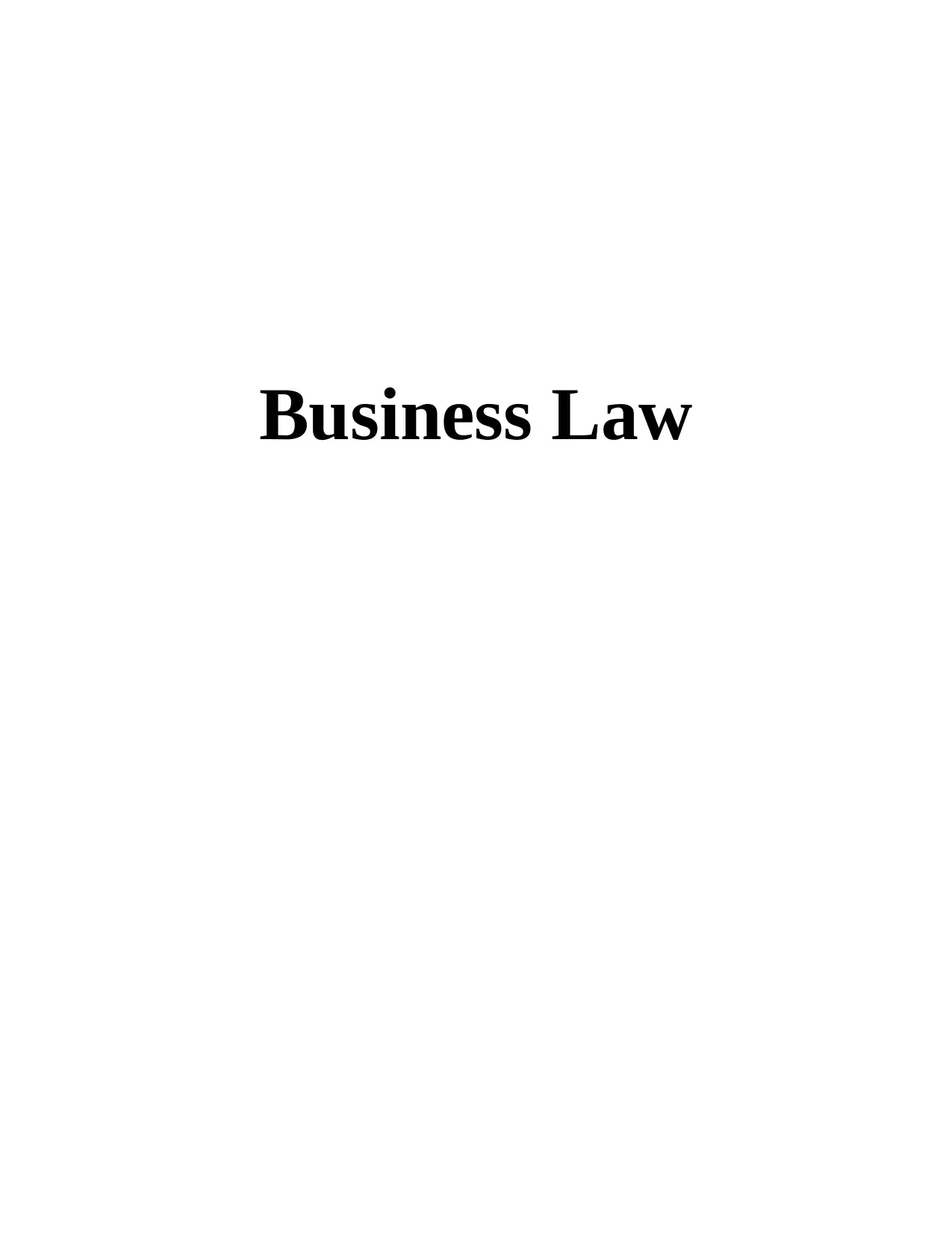
Business Law
Secure Best Marks with AI Grader
Need help grading? Try our AI Grader for instant feedback on your assignments.
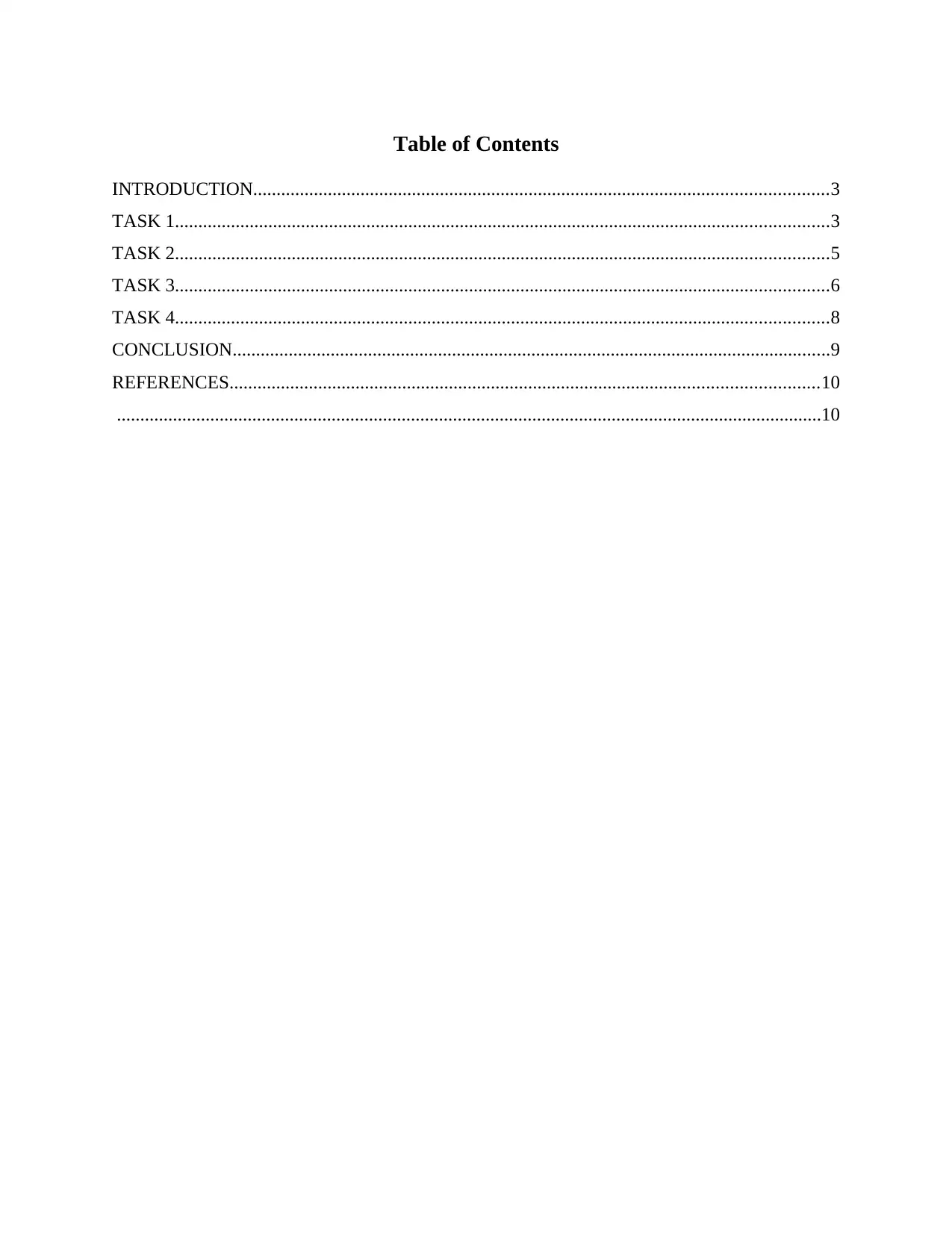
Table of Contents
INTRODUCTION...........................................................................................................................3
TASK 1............................................................................................................................................3
TASK 2............................................................................................................................................5
TASK 3............................................................................................................................................6
TASK 4............................................................................................................................................8
CONCLUSION................................................................................................................................9
REFERENCES..............................................................................................................................10
.......................................................................................................................................................10
INTRODUCTION...........................................................................................................................3
TASK 1............................................................................................................................................3
TASK 2............................................................................................................................................5
TASK 3............................................................................................................................................6
TASK 4............................................................................................................................................8
CONCLUSION................................................................................................................................9
REFERENCES..............................................................................................................................10
.......................................................................................................................................................10
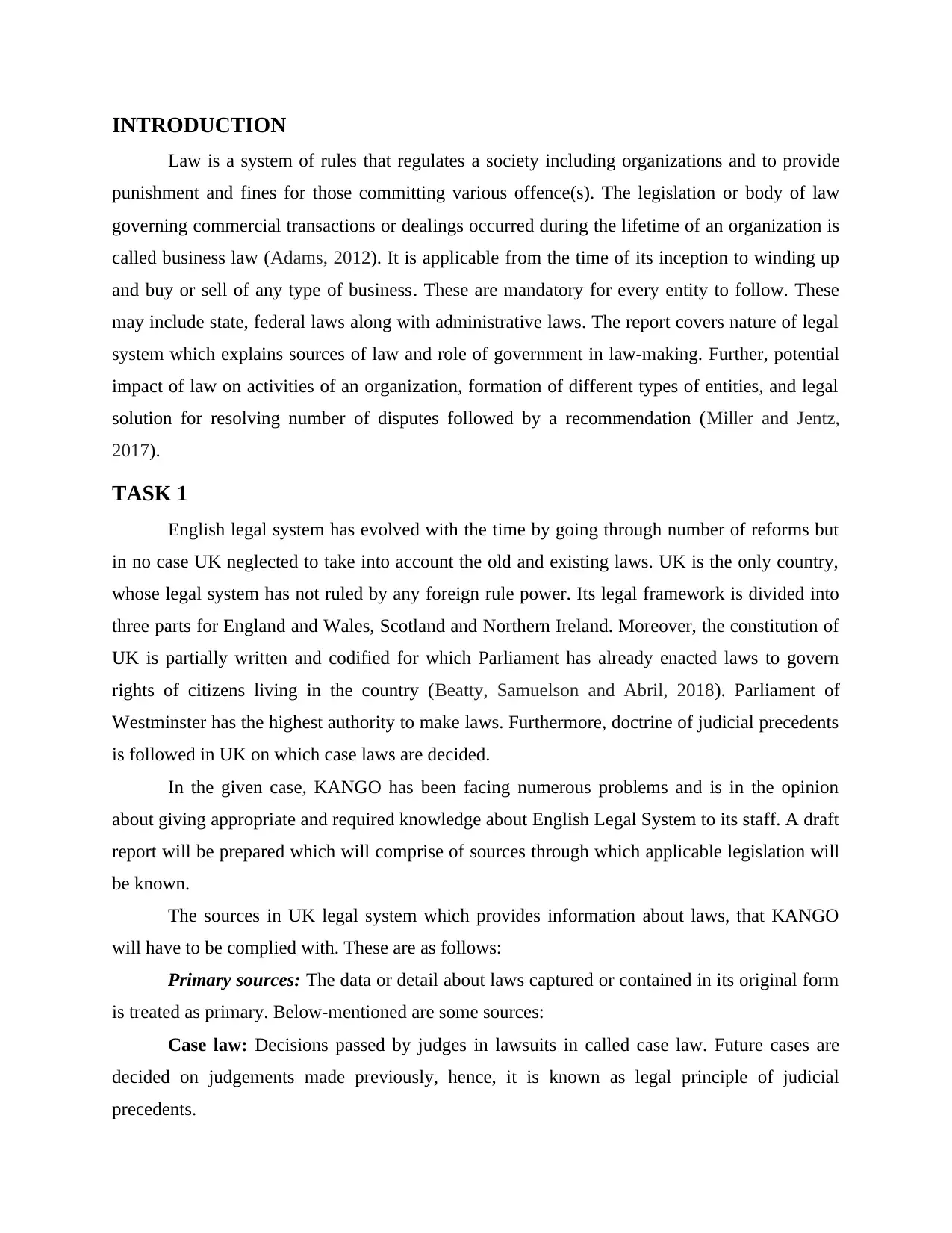
INTRODUCTION
Law is a system of rules that regulates a society including organizations and to provide
punishment and fines for those committing various offence(s). The legislation or body of law
governing commercial transactions or dealings occurred during the lifetime of an organization is
called business law (Adams, 2012). It is applicable from the time of its inception to winding up
and buy or sell of any type of business. These are mandatory for every entity to follow. These
may include state, federal laws along with administrative laws. The report covers nature of legal
system which explains sources of law and role of government in law-making. Further, potential
impact of law on activities of an organization, formation of different types of entities, and legal
solution for resolving number of disputes followed by a recommendation (Miller and Jentz,
2017).
TASK 1
English legal system has evolved with the time by going through number of reforms but
in no case UK neglected to take into account the old and existing laws. UK is the only country,
whose legal system has not ruled by any foreign rule power. Its legal framework is divided into
three parts for England and Wales, Scotland and Northern Ireland. Moreover, the constitution of
UK is partially written and codified for which Parliament has already enacted laws to govern
rights of citizens living in the country (Beatty, Samuelson and Abril, 2018). Parliament of
Westminster has the highest authority to make laws. Furthermore, doctrine of judicial precedents
is followed in UK on which case laws are decided.
In the given case, KANGO has been facing numerous problems and is in the opinion
about giving appropriate and required knowledge about English Legal System to its staff. A draft
report will be prepared which will comprise of sources through which applicable legislation will
be known.
The sources in UK legal system which provides information about laws, that KANGO
will have to be complied with. These are as follows:
Primary sources: The data or detail about laws captured or contained in its original form
is treated as primary. Below-mentioned are some sources:
Case law: Decisions passed by judges in lawsuits in called case law. Future cases are
decided on judgements made previously, hence, it is known as legal principle of judicial
precedents.
Law is a system of rules that regulates a society including organizations and to provide
punishment and fines for those committing various offence(s). The legislation or body of law
governing commercial transactions or dealings occurred during the lifetime of an organization is
called business law (Adams, 2012). It is applicable from the time of its inception to winding up
and buy or sell of any type of business. These are mandatory for every entity to follow. These
may include state, federal laws along with administrative laws. The report covers nature of legal
system which explains sources of law and role of government in law-making. Further, potential
impact of law on activities of an organization, formation of different types of entities, and legal
solution for resolving number of disputes followed by a recommendation (Miller and Jentz,
2017).
TASK 1
English legal system has evolved with the time by going through number of reforms but
in no case UK neglected to take into account the old and existing laws. UK is the only country,
whose legal system has not ruled by any foreign rule power. Its legal framework is divided into
three parts for England and Wales, Scotland and Northern Ireland. Moreover, the constitution of
UK is partially written and codified for which Parliament has already enacted laws to govern
rights of citizens living in the country (Beatty, Samuelson and Abril, 2018). Parliament of
Westminster has the highest authority to make laws. Furthermore, doctrine of judicial precedents
is followed in UK on which case laws are decided.
In the given case, KANGO has been facing numerous problems and is in the opinion
about giving appropriate and required knowledge about English Legal System to its staff. A draft
report will be prepared which will comprise of sources through which applicable legislation will
be known.
The sources in UK legal system which provides information about laws, that KANGO
will have to be complied with. These are as follows:
Primary sources: The data or detail about laws captured or contained in its original form
is treated as primary. Below-mentioned are some sources:
Case law: Decisions passed by judges in lawsuits in called case law. Future cases are
decided on judgements made previously, hence, it is known as legal principle of judicial
precedents.
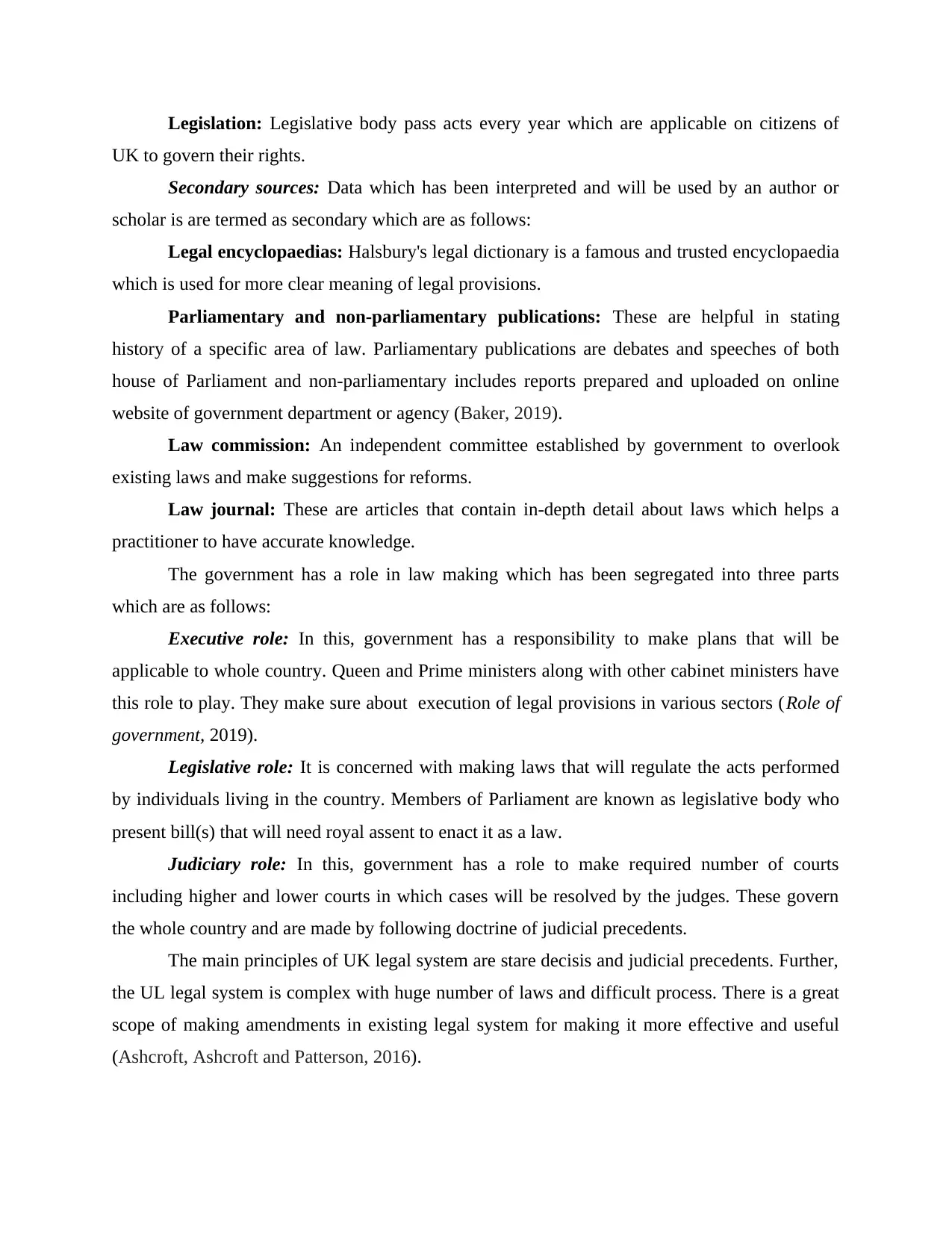
Legislation: Legislative body pass acts every year which are applicable on citizens of
UK to govern their rights.
Secondary sources: Data which has been interpreted and will be used by an author or
scholar is are termed as secondary which are as follows:
Legal encyclopaedias: Halsbury's legal dictionary is a famous and trusted encyclopaedia
which is used for more clear meaning of legal provisions.
Parliamentary and non-parliamentary publications: These are helpful in stating
history of a specific area of law. Parliamentary publications are debates and speeches of both
house of Parliament and non-parliamentary includes reports prepared and uploaded on online
website of government department or agency (Baker, 2019).
Law commission: An independent committee established by government to overlook
existing laws and make suggestions for reforms.
Law journal: These are articles that contain in-depth detail about laws which helps a
practitioner to have accurate knowledge.
The government has a role in law making which has been segregated into three parts
which are as follows:
Executive role: In this, government has a responsibility to make plans that will be
applicable to whole country. Queen and Prime ministers along with other cabinet ministers have
this role to play. They make sure about execution of legal provisions in various sectors (Role of
government, 2019).
Legislative role: It is concerned with making laws that will regulate the acts performed
by individuals living in the country. Members of Parliament are known as legislative body who
present bill(s) that will need royal assent to enact it as a law.
Judiciary role: In this, government has a role to make required number of courts
including higher and lower courts in which cases will be resolved by the judges. These govern
the whole country and are made by following doctrine of judicial precedents.
The main principles of UK legal system are stare decisis and judicial precedents. Further,
the UL legal system is complex with huge number of laws and difficult process. There is a great
scope of making amendments in existing legal system for making it more effective and useful
(Ashcroft, Ashcroft and Patterson, 2016).
UK to govern their rights.
Secondary sources: Data which has been interpreted and will be used by an author or
scholar is are termed as secondary which are as follows:
Legal encyclopaedias: Halsbury's legal dictionary is a famous and trusted encyclopaedia
which is used for more clear meaning of legal provisions.
Parliamentary and non-parliamentary publications: These are helpful in stating
history of a specific area of law. Parliamentary publications are debates and speeches of both
house of Parliament and non-parliamentary includes reports prepared and uploaded on online
website of government department or agency (Baker, 2019).
Law commission: An independent committee established by government to overlook
existing laws and make suggestions for reforms.
Law journal: These are articles that contain in-depth detail about laws which helps a
practitioner to have accurate knowledge.
The government has a role in law making which has been segregated into three parts
which are as follows:
Executive role: In this, government has a responsibility to make plans that will be
applicable to whole country. Queen and Prime ministers along with other cabinet ministers have
this role to play. They make sure about execution of legal provisions in various sectors (Role of
government, 2019).
Legislative role: It is concerned with making laws that will regulate the acts performed
by individuals living in the country. Members of Parliament are known as legislative body who
present bill(s) that will need royal assent to enact it as a law.
Judiciary role: In this, government has a role to make required number of courts
including higher and lower courts in which cases will be resolved by the judges. These govern
the whole country and are made by following doctrine of judicial precedents.
The main principles of UK legal system are stare decisis and judicial precedents. Further,
the UL legal system is complex with huge number of laws and difficult process. There is a great
scope of making amendments in existing legal system for making it more effective and useful
(Ashcroft, Ashcroft and Patterson, 2016).
Secure Best Marks with AI Grader
Need help grading? Try our AI Grader for instant feedback on your assignments.
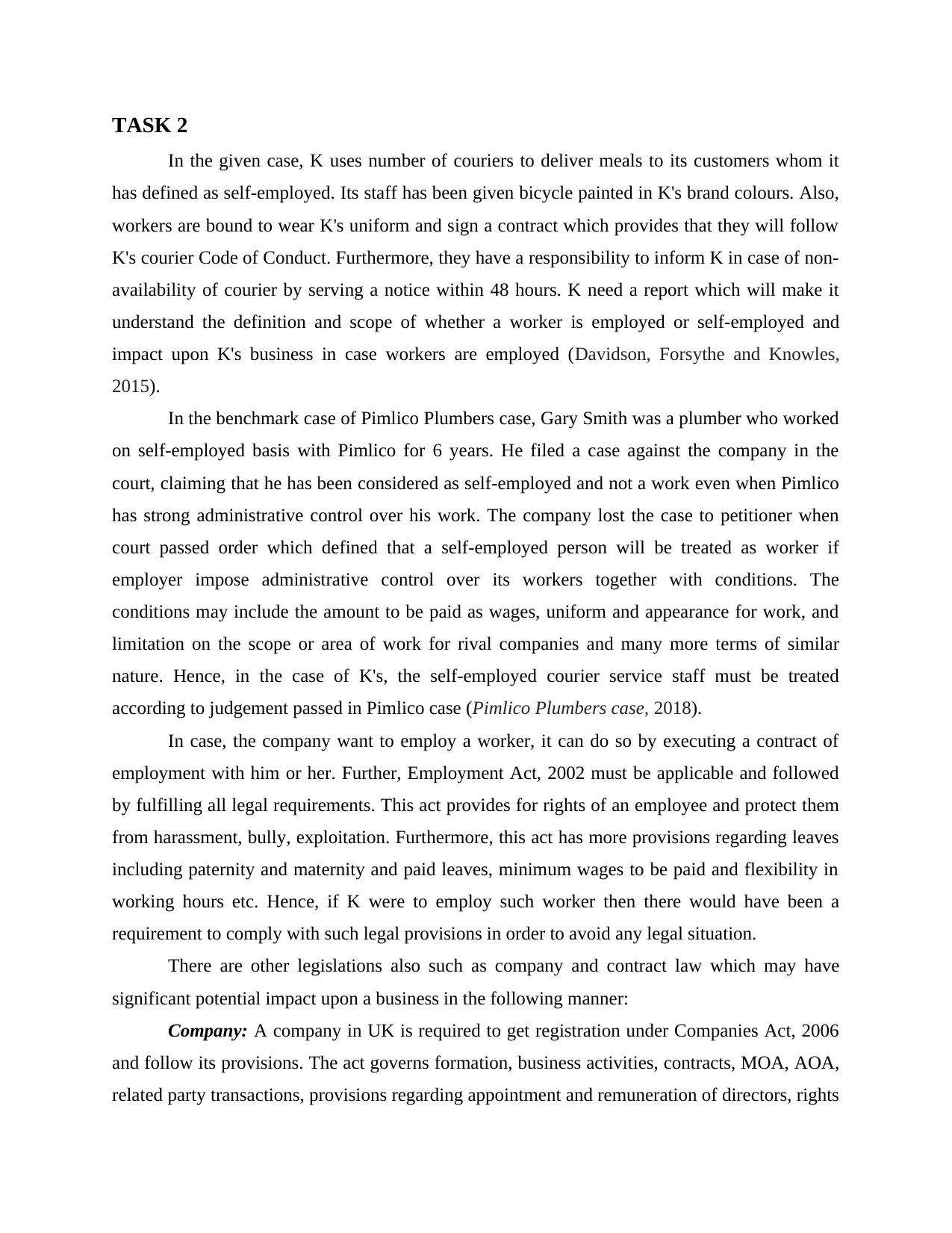
TASK 2
In the given case, K uses number of couriers to deliver meals to its customers whom it
has defined as self-employed. Its staff has been given bicycle painted in K's brand colours. Also,
workers are bound to wear K's uniform and sign a contract which provides that they will follow
K's courier Code of Conduct. Furthermore, they have a responsibility to inform K in case of non-
availability of courier by serving a notice within 48 hours. K need a report which will make it
understand the definition and scope of whether a worker is employed or self-employed and
impact upon K's business in case workers are employed (Davidson, Forsythe and Knowles,
2015).
In the benchmark case of Pimlico Plumbers case, Gary Smith was a plumber who worked
on self-employed basis with Pimlico for 6 years. He filed a case against the company in the
court, claiming that he has been considered as self-employed and not a work even when Pimlico
has strong administrative control over his work. The company lost the case to petitioner when
court passed order which defined that a self-employed person will be treated as worker if
employer impose administrative control over its workers together with conditions. The
conditions may include the amount to be paid as wages, uniform and appearance for work, and
limitation on the scope or area of work for rival companies and many more terms of similar
nature. Hence, in the case of K's, the self-employed courier service staff must be treated
according to judgement passed in Pimlico case (Pimlico Plumbers case, 2018).
In case, the company want to employ a worker, it can do so by executing a contract of
employment with him or her. Further, Employment Act, 2002 must be applicable and followed
by fulfilling all legal requirements. This act provides for rights of an employee and protect them
from harassment, bully, exploitation. Furthermore, this act has more provisions regarding leaves
including paternity and maternity and paid leaves, minimum wages to be paid and flexibility in
working hours etc. Hence, if K were to employ such worker then there would have been a
requirement to comply with such legal provisions in order to avoid any legal situation.
There are other legislations also such as company and contract law which may have
significant potential impact upon a business in the following manner:
Company: A company in UK is required to get registration under Companies Act, 2006
and follow its provisions. The act governs formation, business activities, contracts, MOA, AOA,
related party transactions, provisions regarding appointment and remuneration of directors, rights
In the given case, K uses number of couriers to deliver meals to its customers whom it
has defined as self-employed. Its staff has been given bicycle painted in K's brand colours. Also,
workers are bound to wear K's uniform and sign a contract which provides that they will follow
K's courier Code of Conduct. Furthermore, they have a responsibility to inform K in case of non-
availability of courier by serving a notice within 48 hours. K need a report which will make it
understand the definition and scope of whether a worker is employed or self-employed and
impact upon K's business in case workers are employed (Davidson, Forsythe and Knowles,
2015).
In the benchmark case of Pimlico Plumbers case, Gary Smith was a plumber who worked
on self-employed basis with Pimlico for 6 years. He filed a case against the company in the
court, claiming that he has been considered as self-employed and not a work even when Pimlico
has strong administrative control over his work. The company lost the case to petitioner when
court passed order which defined that a self-employed person will be treated as worker if
employer impose administrative control over its workers together with conditions. The
conditions may include the amount to be paid as wages, uniform and appearance for work, and
limitation on the scope or area of work for rival companies and many more terms of similar
nature. Hence, in the case of K's, the self-employed courier service staff must be treated
according to judgement passed in Pimlico case (Pimlico Plumbers case, 2018).
In case, the company want to employ a worker, it can do so by executing a contract of
employment with him or her. Further, Employment Act, 2002 must be applicable and followed
by fulfilling all legal requirements. This act provides for rights of an employee and protect them
from harassment, bully, exploitation. Furthermore, this act has more provisions regarding leaves
including paternity and maternity and paid leaves, minimum wages to be paid and flexibility in
working hours etc. Hence, if K were to employ such worker then there would have been a
requirement to comply with such legal provisions in order to avoid any legal situation.
There are other legislations also such as company and contract law which may have
significant potential impact upon a business in the following manner:
Company: A company in UK is required to get registration under Companies Act, 2006
and follow its provisions. The act governs formation, business activities, contracts, MOA, AOA,
related party transactions, provisions regarding appointment and remuneration of directors, rights
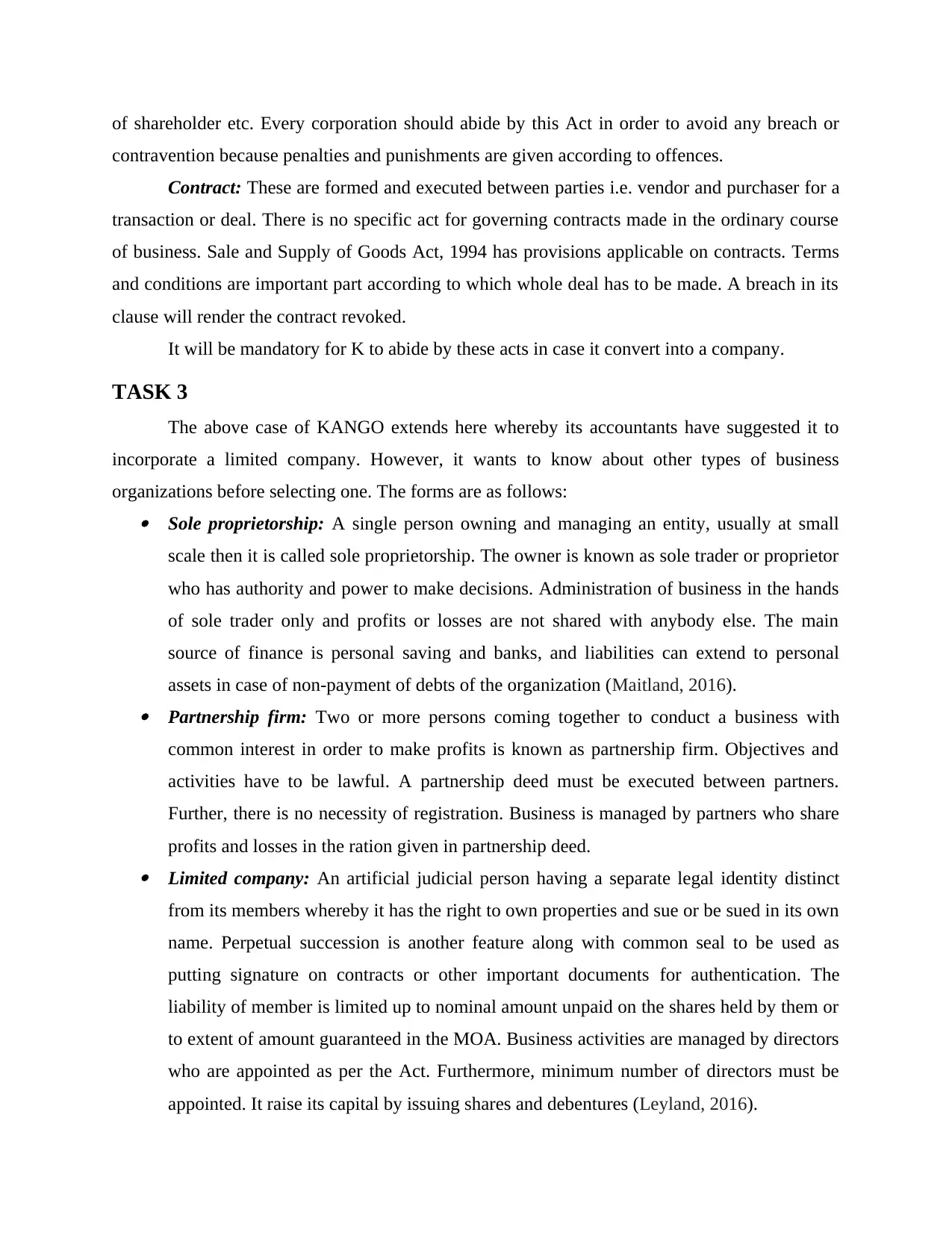
of shareholder etc. Every corporation should abide by this Act in order to avoid any breach or
contravention because penalties and punishments are given according to offences.
Contract: These are formed and executed between parties i.e. vendor and purchaser for a
transaction or deal. There is no specific act for governing contracts made in the ordinary course
of business. Sale and Supply of Goods Act, 1994 has provisions applicable on contracts. Terms
and conditions are important part according to which whole deal has to be made. A breach in its
clause will render the contract revoked.
It will be mandatory for K to abide by these acts in case it convert into a company.
TASK 3
The above case of KANGO extends here whereby its accountants have suggested it to
incorporate a limited company. However, it wants to know about other types of business
organizations before selecting one. The forms are as follows: Sole proprietorship: A single person owning and managing an entity, usually at small
scale then it is called sole proprietorship. The owner is known as sole trader or proprietor
who has authority and power to make decisions. Administration of business in the hands
of sole trader only and profits or losses are not shared with anybody else. The main
source of finance is personal saving and banks, and liabilities can extend to personal
assets in case of non-payment of debts of the organization (Maitland, 2016). Partnership firm: Two or more persons coming together to conduct a business with
common interest in order to make profits is known as partnership firm. Objectives and
activities have to be lawful. A partnership deed must be executed between partners.
Further, there is no necessity of registration. Business is managed by partners who share
profits and losses in the ration given in partnership deed. Limited company: An artificial judicial person having a separate legal identity distinct
from its members whereby it has the right to own properties and sue or be sued in its own
name. Perpetual succession is another feature along with common seal to be used as
putting signature on contracts or other important documents for authentication. The
liability of member is limited up to nominal amount unpaid on the shares held by them or
to extent of amount guaranteed in the MOA. Business activities are managed by directors
who are appointed as per the Act. Furthermore, minimum number of directors must be
appointed. It raise its capital by issuing shares and debentures (Leyland, 2016).
contravention because penalties and punishments are given according to offences.
Contract: These are formed and executed between parties i.e. vendor and purchaser for a
transaction or deal. There is no specific act for governing contracts made in the ordinary course
of business. Sale and Supply of Goods Act, 1994 has provisions applicable on contracts. Terms
and conditions are important part according to which whole deal has to be made. A breach in its
clause will render the contract revoked.
It will be mandatory for K to abide by these acts in case it convert into a company.
TASK 3
The above case of KANGO extends here whereby its accountants have suggested it to
incorporate a limited company. However, it wants to know about other types of business
organizations before selecting one. The forms are as follows: Sole proprietorship: A single person owning and managing an entity, usually at small
scale then it is called sole proprietorship. The owner is known as sole trader or proprietor
who has authority and power to make decisions. Administration of business in the hands
of sole trader only and profits or losses are not shared with anybody else. The main
source of finance is personal saving and banks, and liabilities can extend to personal
assets in case of non-payment of debts of the organization (Maitland, 2016). Partnership firm: Two or more persons coming together to conduct a business with
common interest in order to make profits is known as partnership firm. Objectives and
activities have to be lawful. A partnership deed must be executed between partners.
Further, there is no necessity of registration. Business is managed by partners who share
profits and losses in the ration given in partnership deed. Limited company: An artificial judicial person having a separate legal identity distinct
from its members whereby it has the right to own properties and sue or be sued in its own
name. Perpetual succession is another feature along with common seal to be used as
putting signature on contracts or other important documents for authentication. The
liability of member is limited up to nominal amount unpaid on the shares held by them or
to extent of amount guaranteed in the MOA. Business activities are managed by directors
who are appointed as per the Act. Furthermore, minimum number of directors must be
appointed. It raise its capital by issuing shares and debentures (Leyland, 2016).
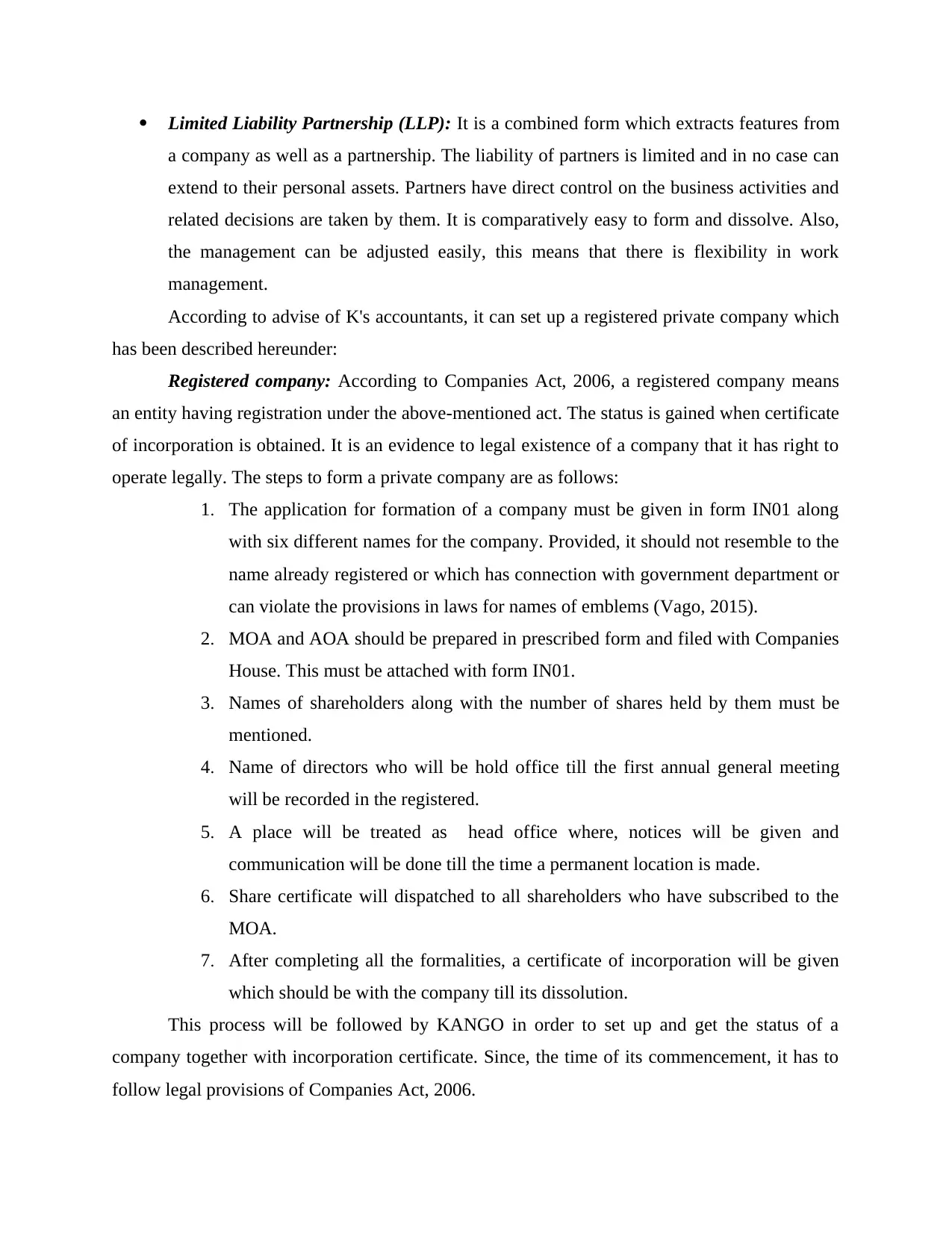
Limited Liability Partnership (LLP): It is a combined form which extracts features from
a company as well as a partnership. The liability of partners is limited and in no case can
extend to their personal assets. Partners have direct control on the business activities and
related decisions are taken by them. It is comparatively easy to form and dissolve. Also,
the management can be adjusted easily, this means that there is flexibility in work
management.
According to advise of K's accountants, it can set up a registered private company which
has been described hereunder:
Registered company: According to Companies Act, 2006, a registered company means
an entity having registration under the above-mentioned act. The status is gained when certificate
of incorporation is obtained. It is an evidence to legal existence of a company that it has right to
operate legally. The steps to form a private company are as follows:
1. The application for formation of a company must be given in form IN01 along
with six different names for the company. Provided, it should not resemble to the
name already registered or which has connection with government department or
can violate the provisions in laws for names of emblems (Vago, 2015).
2. MOA and AOA should be prepared in prescribed form and filed with Companies
House. This must be attached with form IN01.
3. Names of shareholders along with the number of shares held by them must be
mentioned.
4. Name of directors who will be hold office till the first annual general meeting
will be recorded in the registered.
5. A place will be treated as head office where, notices will be given and
communication will be done till the time a permanent location is made.
6. Share certificate will dispatched to all shareholders who have subscribed to the
MOA.
7. After completing all the formalities, a certificate of incorporation will be given
which should be with the company till its dissolution.
This process will be followed by KANGO in order to set up and get the status of a
company together with incorporation certificate. Since, the time of its commencement, it has to
follow legal provisions of Companies Act, 2006.
a company as well as a partnership. The liability of partners is limited and in no case can
extend to their personal assets. Partners have direct control on the business activities and
related decisions are taken by them. It is comparatively easy to form and dissolve. Also,
the management can be adjusted easily, this means that there is flexibility in work
management.
According to advise of K's accountants, it can set up a registered private company which
has been described hereunder:
Registered company: According to Companies Act, 2006, a registered company means
an entity having registration under the above-mentioned act. The status is gained when certificate
of incorporation is obtained. It is an evidence to legal existence of a company that it has right to
operate legally. The steps to form a private company are as follows:
1. The application for formation of a company must be given in form IN01 along
with six different names for the company. Provided, it should not resemble to the
name already registered or which has connection with government department or
can violate the provisions in laws for names of emblems (Vago, 2015).
2. MOA and AOA should be prepared in prescribed form and filed with Companies
House. This must be attached with form IN01.
3. Names of shareholders along with the number of shares held by them must be
mentioned.
4. Name of directors who will be hold office till the first annual general meeting
will be recorded in the registered.
5. A place will be treated as head office where, notices will be given and
communication will be done till the time a permanent location is made.
6. Share certificate will dispatched to all shareholders who have subscribed to the
MOA.
7. After completing all the formalities, a certificate of incorporation will be given
which should be with the company till its dissolution.
This process will be followed by KANGO in order to set up and get the status of a
company together with incorporation certificate. Since, the time of its commencement, it has to
follow legal provisions of Companies Act, 2006.
Paraphrase This Document
Need a fresh take? Get an instant paraphrase of this document with our AI Paraphraser
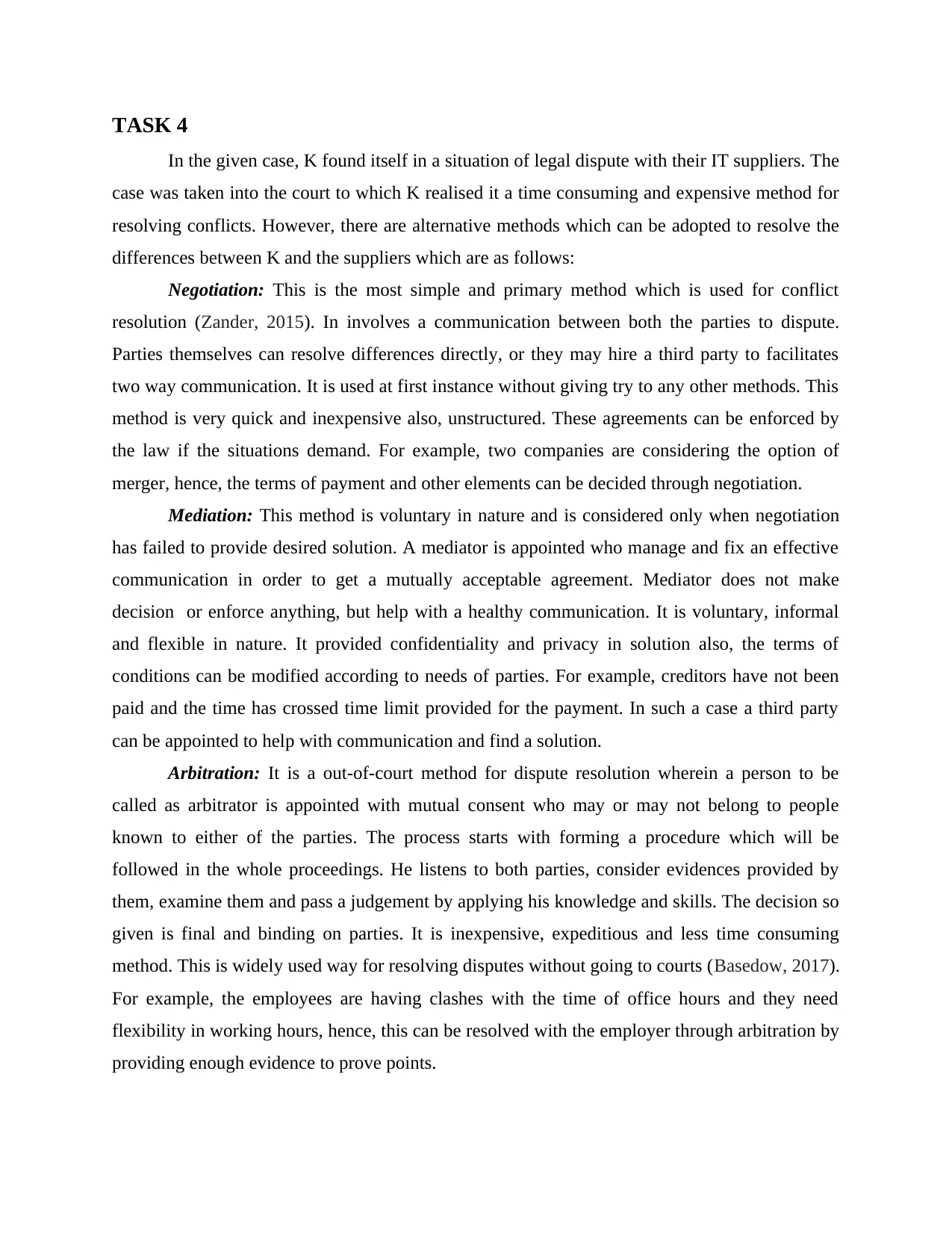
TASK 4
In the given case, K found itself in a situation of legal dispute with their IT suppliers. The
case was taken into the court to which K realised it a time consuming and expensive method for
resolving conflicts. However, there are alternative methods which can be adopted to resolve the
differences between K and the suppliers which are as follows:
Negotiation: This is the most simple and primary method which is used for conflict
resolution (Zander, 2015). In involves a communication between both the parties to dispute.
Parties themselves can resolve differences directly, or they may hire a third party to facilitates
two way communication. It is used at first instance without giving try to any other methods. This
method is very quick and inexpensive also, unstructured. These agreements can be enforced by
the law if the situations demand. For example, two companies are considering the option of
merger, hence, the terms of payment and other elements can be decided through negotiation.
Mediation: This method is voluntary in nature and is considered only when negotiation
has failed to provide desired solution. A mediator is appointed who manage and fix an effective
communication in order to get a mutually acceptable agreement. Mediator does not make
decision or enforce anything, but help with a healthy communication. It is voluntary, informal
and flexible in nature. It provided confidentiality and privacy in solution also, the terms of
conditions can be modified according to needs of parties. For example, creditors have not been
paid and the time has crossed time limit provided for the payment. In such a case a third party
can be appointed to help with communication and find a solution.
Arbitration: It is a out-of-court method for dispute resolution wherein a person to be
called as arbitrator is appointed with mutual consent who may or may not belong to people
known to either of the parties. The process starts with forming a procedure which will be
followed in the whole proceedings. He listens to both parties, consider evidences provided by
them, examine them and pass a judgement by applying his knowledge and skills. The decision so
given is final and binding on parties. It is inexpensive, expeditious and less time consuming
method. This is widely used way for resolving disputes without going to courts (Basedow, 2017).
For example, the employees are having clashes with the time of office hours and they need
flexibility in working hours, hence, this can be resolved with the employer through arbitration by
providing enough evidence to prove points.
In the given case, K found itself in a situation of legal dispute with their IT suppliers. The
case was taken into the court to which K realised it a time consuming and expensive method for
resolving conflicts. However, there are alternative methods which can be adopted to resolve the
differences between K and the suppliers which are as follows:
Negotiation: This is the most simple and primary method which is used for conflict
resolution (Zander, 2015). In involves a communication between both the parties to dispute.
Parties themselves can resolve differences directly, or they may hire a third party to facilitates
two way communication. It is used at first instance without giving try to any other methods. This
method is very quick and inexpensive also, unstructured. These agreements can be enforced by
the law if the situations demand. For example, two companies are considering the option of
merger, hence, the terms of payment and other elements can be decided through negotiation.
Mediation: This method is voluntary in nature and is considered only when negotiation
has failed to provide desired solution. A mediator is appointed who manage and fix an effective
communication in order to get a mutually acceptable agreement. Mediator does not make
decision or enforce anything, but help with a healthy communication. It is voluntary, informal
and flexible in nature. It provided confidentiality and privacy in solution also, the terms of
conditions can be modified according to needs of parties. For example, creditors have not been
paid and the time has crossed time limit provided for the payment. In such a case a third party
can be appointed to help with communication and find a solution.
Arbitration: It is a out-of-court method for dispute resolution wherein a person to be
called as arbitrator is appointed with mutual consent who may or may not belong to people
known to either of the parties. The process starts with forming a procedure which will be
followed in the whole proceedings. He listens to both parties, consider evidences provided by
them, examine them and pass a judgement by applying his knowledge and skills. The decision so
given is final and binding on parties. It is inexpensive, expeditious and less time consuming
method. This is widely used way for resolving disputes without going to courts (Basedow, 2017).
For example, the employees are having clashes with the time of office hours and they need
flexibility in working hours, hence, this can be resolved with the employer through arbitration by
providing enough evidence to prove points.
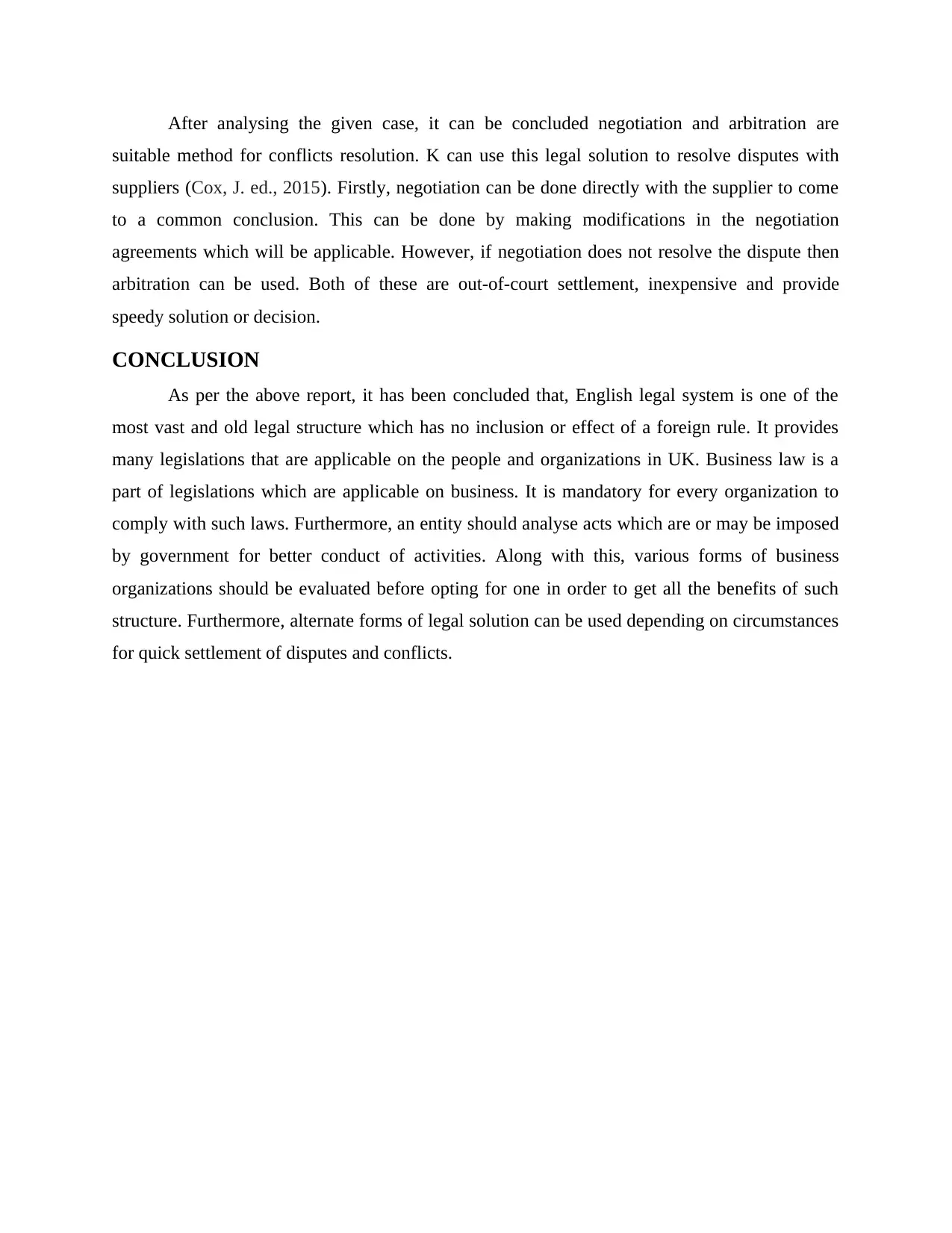
After analysing the given case, it can be concluded negotiation and arbitration are
suitable method for conflicts resolution. K can use this legal solution to resolve disputes with
suppliers (Cox, J. ed., 2015). Firstly, negotiation can be done directly with the supplier to come
to a common conclusion. This can be done by making modifications in the negotiation
agreements which will be applicable. However, if negotiation does not resolve the dispute then
arbitration can be used. Both of these are out-of-court settlement, inexpensive and provide
speedy solution or decision.
CONCLUSION
As per the above report, it has been concluded that, English legal system is one of the
most vast and old legal structure which has no inclusion or effect of a foreign rule. It provides
many legislations that are applicable on the people and organizations in UK. Business law is a
part of legislations which are applicable on business. It is mandatory for every organization to
comply with such laws. Furthermore, an entity should analyse acts which are or may be imposed
by government for better conduct of activities. Along with this, various forms of business
organizations should be evaluated before opting for one in order to get all the benefits of such
structure. Furthermore, alternate forms of legal solution can be used depending on circumstances
for quick settlement of disputes and conflicts.
suitable method for conflicts resolution. K can use this legal solution to resolve disputes with
suppliers (Cox, J. ed., 2015). Firstly, negotiation can be done directly with the supplier to come
to a common conclusion. This can be done by making modifications in the negotiation
agreements which will be applicable. However, if negotiation does not resolve the dispute then
arbitration can be used. Both of these are out-of-court settlement, inexpensive and provide
speedy solution or decision.
CONCLUSION
As per the above report, it has been concluded that, English legal system is one of the
most vast and old legal structure which has no inclusion or effect of a foreign rule. It provides
many legislations that are applicable on the people and organizations in UK. Business law is a
part of legislations which are applicable on business. It is mandatory for every organization to
comply with such laws. Furthermore, an entity should analyse acts which are or may be imposed
by government for better conduct of activities. Along with this, various forms of business
organizations should be evaluated before opting for one in order to get all the benefits of such
structure. Furthermore, alternate forms of legal solution can be used depending on circumstances
for quick settlement of disputes and conflicts.
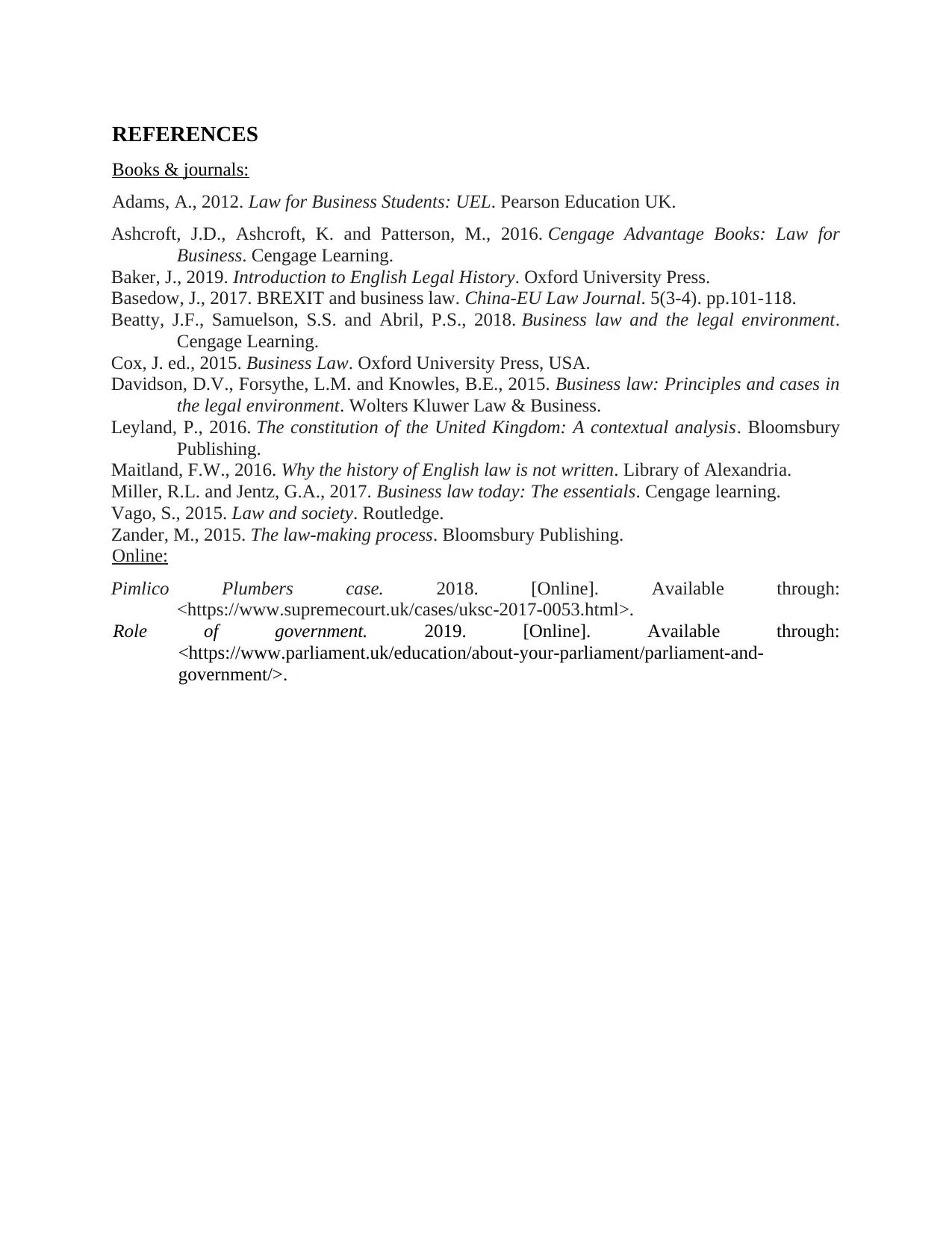
REFERENCES
Books & journals:
Adams, A., 2012. Law for Business Students: UEL. Pearson Education UK.
Ashcroft, J.D., Ashcroft, K. and Patterson, M., 2016. Cengage Advantage Books: Law for
Business. Cengage Learning.
Baker, J., 2019. Introduction to English Legal History. Oxford University Press.
Basedow, J., 2017. BREXIT and business law. China-EU Law Journal. 5(3-4). pp.101-118.
Beatty, J.F., Samuelson, S.S. and Abril, P.S., 2018. Business law and the legal environment.
Cengage Learning.
Cox, J. ed., 2015. Business Law. Oxford University Press, USA.
Davidson, D.V., Forsythe, L.M. and Knowles, B.E., 2015. Business law: Principles and cases in
the legal environment. Wolters Kluwer Law & Business.
Leyland, P., 2016. The constitution of the United Kingdom: A contextual analysis. Bloomsbury
Publishing.
Maitland, F.W., 2016. Why the history of English law is not written. Library of Alexandria.
Miller, R.L. and Jentz, G.A., 2017. Business law today: The essentials. Cengage learning.
Vago, S., 2015. Law and society. Routledge.
Zander, M., 2015. The law-making process. Bloomsbury Publishing.
Online:
Pimlico Plumbers case. 2018. [Online]. Available through:
<https://www.supremecourt.uk/cases/uksc-2017-0053.html>.
Role of government. 2019. [Online]. Available through:
<https://www.parliament.uk/education/about-your-parliament/parliament-and-
government/>.
Books & journals:
Adams, A., 2012. Law for Business Students: UEL. Pearson Education UK.
Ashcroft, J.D., Ashcroft, K. and Patterson, M., 2016. Cengage Advantage Books: Law for
Business. Cengage Learning.
Baker, J., 2019. Introduction to English Legal History. Oxford University Press.
Basedow, J., 2017. BREXIT and business law. China-EU Law Journal. 5(3-4). pp.101-118.
Beatty, J.F., Samuelson, S.S. and Abril, P.S., 2018. Business law and the legal environment.
Cengage Learning.
Cox, J. ed., 2015. Business Law. Oxford University Press, USA.
Davidson, D.V., Forsythe, L.M. and Knowles, B.E., 2015. Business law: Principles and cases in
the legal environment. Wolters Kluwer Law & Business.
Leyland, P., 2016. The constitution of the United Kingdom: A contextual analysis. Bloomsbury
Publishing.
Maitland, F.W., 2016. Why the history of English law is not written. Library of Alexandria.
Miller, R.L. and Jentz, G.A., 2017. Business law today: The essentials. Cengage learning.
Vago, S., 2015. Law and society. Routledge.
Zander, M., 2015. The law-making process. Bloomsbury Publishing.
Online:
Pimlico Plumbers case. 2018. [Online]. Available through:
<https://www.supremecourt.uk/cases/uksc-2017-0053.html>.
Role of government. 2019. [Online]. Available through:
<https://www.parliament.uk/education/about-your-parliament/parliament-and-
government/>.
1 out of 10
Related Documents
Your All-in-One AI-Powered Toolkit for Academic Success.
+13062052269
info@desklib.com
Available 24*7 on WhatsApp / Email
![[object Object]](/_next/static/media/star-bottom.7253800d.svg)
Unlock your academic potential
© 2024 | Zucol Services PVT LTD | All rights reserved.





